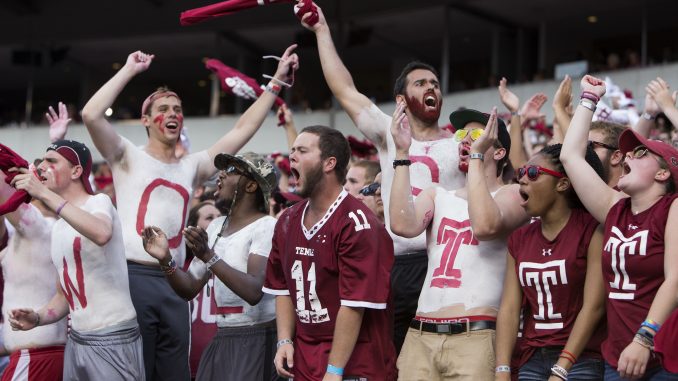
 Former President Neil Theobald often called football the “front porch” of the university. In the last two years, the curb appeal has been tremendous.
Former President Neil Theobald often called football the “front porch” of the university. In the last two years, the curb appeal has been tremendous.
A record number of students attended Temple’s open house on Nov. 8, 2015, just eight days after ESPN’s College GameDay came to Independence Mall and Temple played a ranked University of Notre Dame team in the primetime Saturday night slot on ABC at Lincoln Financial Field.
Temple (3-5, 1-3 American Athletic Conference) opened its season on Sept. 2 against Notre Dame in South Bend, Indiana, to close its three-game series against the Fighting Irish. More than 77,000 people, Notre Dame’s 256th consecutive sellout crowd dating back to 1974, filed into the stadium to watch the Fighting Irish beat the Owls, 49-16.
As part of Notre Dame’s enhancements to its stadium, the school debuted a videoboard in 2017. If you go to Notre Dame Stadium, you’re there for football, and that’s it.
Temple wants to replicate Notre Dame’s on-campus game experience on a smaller scale with a potential 35,000-seat, $130 million stadium at 15th and Norris streets. But few places are like Notre Dame.
National trends show people are less interested in the in-person experience across the Football Bowl Subdivision level. So if any stadium, including Temple’s proposed on-campus facility, is to be successful in filling seats, it can’t simply rely on the on-field product.
What is offered to fans before kickoff and during breaks in action is important now more than ever.
Attendance at FBS games decreased for the sixth year in a row in 2016 when an average of 43,106 was reported at home games. Crowds peaked at an average of 46,565 in 2008.
“More than ever, college football programs are finding it difficult to draw and retain the young fans who grow up to be lifelong season-ticket holders,” the New York Times’ Marc Tracy wrote in September 2016.
The response from athletic departments has been to engage students with off-field experiences and incentives. At Temple, a concerted effort has been made to enhance the gameday experience. It starts the day before games, when a pep rally is held on Main Campus. The rallies only used to happen before big games, like when Temple played Penn State in 2011, said Scott Walcoff, the senior associate athletic director of external operations who has worked in marketing and promotions at Temple since 2005.
Once Pat Kraft, currently the athletic director, arrived as the deputy director of athletics in 2013, Temple decided to move the pre-game vendors and entertainment from HeadHouse Plaza, an area within the Lincoln Financial Field gates, to the parking lot to offer it to people before they had their tickets scanned.
This year, Temple has also worked with Blockparty Suites — the athletic department’s official tailgate partner — to offer lounges with an all-you-can-drink bar and high-definition television in the parking lot. The athletic department got the idea when Temple played Southern Methodist in Dallas in 2015.
“It’s starting to look like what a big-time college football pre-game atmosphere should be,” Walcoff said. “We’re starting to build that.”
The eye test and the numbers agree.
At Temple, the average crowd increased by nearly 8,000 people from 2010 to 2011, when the Owls won their first bowl game since 1979. The largest increase during the stretch from 2005 to 2016 occurred from 2014 to 2015, when the Owls — aided by sellouts against Penn State and Notre Dame — averaged 44,158 fans at their home games.
Through its first four home games in 2017, Temple has an average attendance of about 27,975 people, which is about 1,353 people more than the first four games last year.
Temple hasn’t hosted a Power Five school since the 2015 season opener against Penn State and isn’t scheduled to until September 2019 against the University of Maryland. Home games against Georgia Tech in 2019, Rutgers University in 2020 and 2022 and Boston College in 2021 could continue to boost attendance.
None of those teams, including Temple, however, is guaranteed to be good by the time those games will be played. Success, as demonstrated by this year’s Temple team, can be either long-lasting or fleeting.
So if Temple is to continue boosting attendance, it has to keep improving its tailgating and in-game promotions no matter where it plays the games.
“When and if that time comes that we get an on-campus stadium, I have no doubt that we will be able to replicate what we do at Lincoln Financial Field to possibly having something on Temple’s campus,” Walcoff said. “Whether it be Liacouras Walk, whether it be the center area of campus now where the Bell Tower is, I think there’s enough areas that we would be able to hopefully do something with.”


Be the first to comment